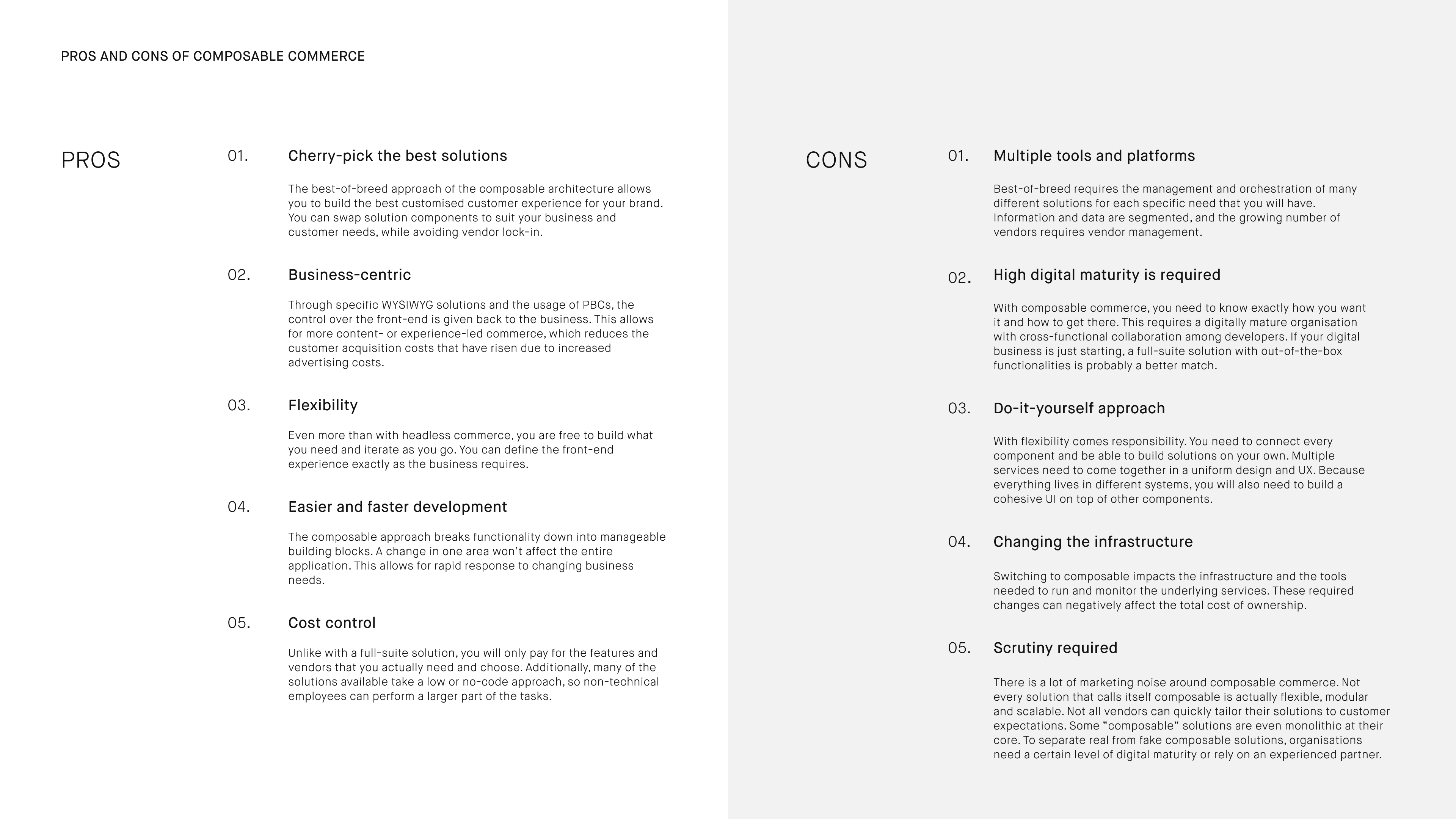Where headless commerce only separates the content from the commerce platform, composable commerce takes the best-of-breed approach to an atomic level. Every component of the commerce experience, from search to payment and everything in between, can be addressed by an independent solution or tool. While this approach may sound like a magnification of the challenges with headless, its focus on business functionality gives control over the customer experience back to the business.
The term composable commerce was first coined by Gartner in its 2020 research Composable Commerce Must Be Adopted for the Future of Applications. This paper explains that headless has become a buzzword that is not even a great name for this new approach, because it still needs a head or a UI. In fact, there are many heads that must provide a seamless digital experience. Early adopters of the headless approach experienced this problem first-hand, as their business was no longer able to manage aspects of the digital experience. So instead of a “headless” approach, the solution lies in adopting an incremental, modular approach with packaged business capabilities that retain control of presentation to the business user; composable commerce.
What is composable commerce?
Composable commerce is a development approach that uses packaged business capabilities (PBC) to create a modern commerce experience that is defined by the business. The resulting composable architecture is built from – or composed of – best-of-breed commerce components. Each component can be deployed and interchanged independently, which enables integration with any application available. This open character of composable commerce gives the freedom and flexibility to create a totally unique and tailored commerce experience. For this reason, Gartner sees composable as the future of applications and predicts that by 2023,organisations adopting an intelligent composable approach will outpace the competition by 80%.
In The Forrester Wave™ B2C Commerce Solutions for Q2 2022, Forrester states that modular, cloud-native commerce solutions are no longer just for the most digitally mature companies: “Modern commerce tech is more adaptive and provides resilience for the digital businesses that use it.”
Composable commerce puts the business first
The key difference between headless and composable commerce is the usage of packaged business capabilities (PBCs). Gartner defines PBCs as software components that represent a well-defined business capability that is functionally recognisable as such by a business user. PBCs address specific business needs such as search, payment, CRM, shipping, inventory management etc. Every PBC is pluggable, scalable and replaceable without affecting the rest. As such, composable commerce is business-oriented, whereas headless commerce is developer-oriented.
PBCs are composed of several smaller components called microservices. These are autonomous services that all work together. While they are often tiny, some microservices do match the standards for a PBC. Technically, a PBC includes a bounded set of a data schema and a set of services, APIs, and event channels. When talking about composable commerce, business users should focus on PBCs to keep the focus on business functionality.
The pros and cons of composable commerce
Any company struggling with headless commerce is probably not thrilled to hear another buzzword as the solution to all their problems. But for many e-commerce applications, using headless commerce is the first step to a composable architecture. The following list of pros and cons is aimed at helping you to better understand the impact of switching to a composable architecture and decide whether it is the right choice for you:

When is composable commerce the right choice?
The key considerations for choosing composable commerce are:
- How important are optimal commerce experiences in your market? Is your market competitive and rapidly changing?
- How complex is your current infrastructure? Do you need to freeze all deployments a month before Black Friday to prevent breaking the webshop for example?
- To which extent is the marketing department dependent on the IT department? Who controls the front-end experience?
- How flexible can your architecture scale as needed?
- How important is innovation for your long-term success? Does your current architecture offer the flexibility and time-to-market that you need?
- Can your IT department face the tech debt that comes with connecting and maintaining various tools?
How to start with composable commerce
The composable approach lets you pick the best solution for the specific business needs you have. Its starting point is the notion that there isn’t one best solution for everything that works for everybody.
In our whitepaper, The Ultimate Guide to Headless and Composable Commerce, we explore how the composable architecture builds on the headless approach and puts marketing back in control of the front-end experience. We interviewed five leading solution providers to give you a rich overview of the solid solutions available to companies struggling with headless.
More Insights?
View all InsightsQuestions?
Managing Director UK





